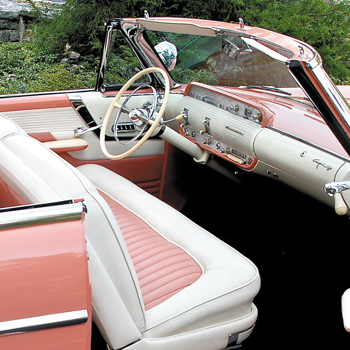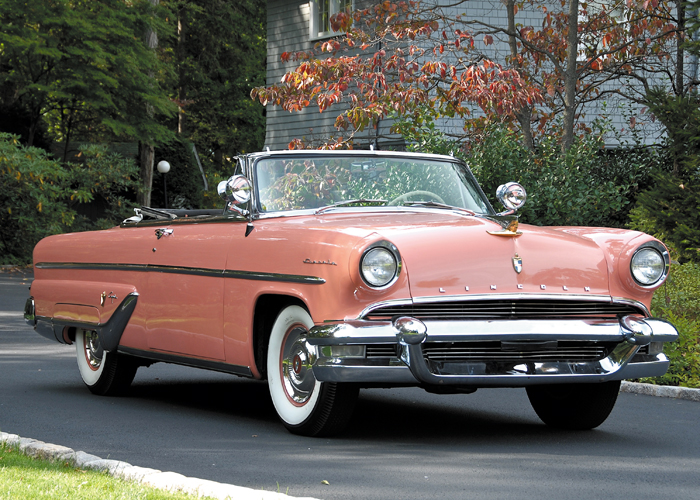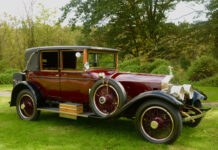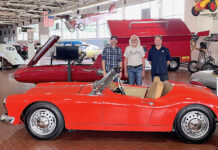By Jay Hirsch
“The first function of a fine car is outstanding performance!”
This was a headline in an ad for the 1955 Lincoln. Coming off of winning the stockcar class in the Mexican Road Races of 1952, 1953 and 1954, Lincoln could not only “talk the talk,” it could “walk the walk.” The Mexican Road Race, also known as the Pan American Road Race, was 1,933 miles over roads from sea level to 10,380 feet. In 1954, a stock Lincoln averaged 98 mph on the course.
For 1955 Lincoln switched from the Hydramatic transmission to the Ford Turbo-Drive automatic transmission, made in their Livonia, Mich., factory. This transmission is a torque converter hitched to a three-speed set of planetary gears. When starting out in “D/drive,” the transmission is in second gear, but if the pedal is pushed all the way down, as in “pedal to the metal,” you get a low gear start, with a 0-60 mph of twelve seconds. For a 4,300-pound car with the interior refinements of a country estate, this was “hot.” To put it in perspective, a 1955 Por

sche 356, which costed $3,600 and weighed 2,000 pounds, went from 0-60 mph in 13 seconds and had a top speed of 95 mph. The 1955 Lincoln had a top speed of 110 mph.
As for cornering, whether it be a 1955 Lincoln, a 1955 Porsche or any 1955 car, much of the handling was related to the bias ply tire of the day, which doesn’t compare to the radial tire of today. Put a set of bias ply tires on a modern Corvette, Mustang or Porsche, and you have the cornering of a 1955 car. The suspensions on today’s cars are designed for today’s radial tires.
The 1955 Lincoln, seen here in Cashmere Coral, is a relatively “low mileage” car. It has 85,000 miles and was always garaged and used as a second or third car by its original owner. who lived in Plymouth, Mich.
“It probably saw more use in
their winter home in Palm Beach than in the spring and summers of Plymouth,” the current owner, Jack Bart, told me.
The car has been repainted, as the original paint was getting dull from sun exposure. In 2005, the leather seats had new hides done in the same design as the original leather, and at that time a new white top was installed. The engine also had its valves on the cylinder head reground, but the engine was never out of the car and needed no work.
“Seems changing the oil three times a year pays off in the long run,” Jack said.
As for those bias ply tires, “since we do not drive the car every day and only on warm spring and summer days, we went for the look of the four-inch-wide-whites, which were on the car when new,” Jack said. “I know the inherent features of bias ply, so there is no problem there. Anyway who wants to go fast with this car, you want to go slow and cruise, so people car drool when they see the car, and drool they do. When we stop at the Dairy Queen, people surround the car like bee’s to honey.”
Jack is a “car collector” and his stable of cars runs from a 1941 Buick Woody, 1956 Mercedes SL gullwing, sports cars of the 1970s and American cars from the 1930s to 1950s.
“I always liked the look of the Ford line up of cars from 1955 to 1957, especially the pastel colors offered. As far as I am concerned, Ford has the best array of 1950 pastel colors,” Jack said. “Owning a 1955 Mercury Sun Valley, I knew I had to have a 1955 Lincoln convertible. Some people prefer the 1956 Lincoln, but I like the smaller size of the 1955 Lincoln and the way it handles. You do not have that big car ride, which is what I like. If a 1956 Lincoln coupe or convertible in the right color did come up though, I would be on it!”
Whether riding in the Lincoln around town or on the Interstate, the ride is pure joy. At 70 mph the car is an extremely smooth, riding like a “sun-room on wheels.” As long as there are no ruts on the highway from the 18-wheelers of today, the Lincoln with its bias-ply wide-whites is a pleasure to drive and ride in.
One major feature of the 1955 Lincoln is the height of the car and the design of the seats. The comfort of your legs “hanging down” as opposed to stretched out almost flat, as in many of today’s cars, can only be appreciated after riding for an hour or more. The only comparison would be in today’s SUV or pick up, which may be an underlying reason why they are so popular.
In April 1955, Lincoln became a separate division of the Ford Motor Company. That same year 1,487 Lincoln Capri convertibles were sold. •



